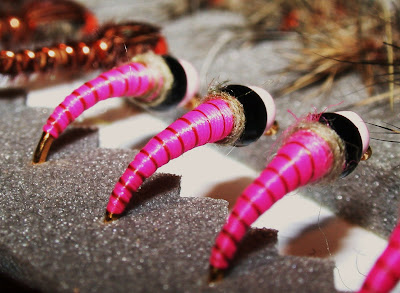
It was a rather misty day on the River Test at Wherwell today. Fishing was with Peter Anderson, Vince and Tony. Starting the day with small nymphs we worked our way upstream, pitching the nymphs through all the likely looking runs. With a niggling breeze pushing downstream, it took a little while to find the fish in a feeding mood. Eventually we located a few fish - and there were some substantial grayling amongst them including a couple over the 2lb mark. With a hatch of Pale Wateries and Large Dark olives beginning to show, it was an out of season trout taking a partidge and orange on the dropper that gave me the first hook up of the day. It wasn't long before the first of the grayling found its way to hand. With a larger shrimp pattern on the point and a spider on the dropper, the fish were a little more willing to take the fly. Perhaps the wind had eased because sighting and targetting fish was the way forward.
One on a pale beige shrimp:

Lunchtime seemed to creep up on us - it's amazing just how much time can be absorbed trying to tempt fish you can see to take your offering. On the way back to the car park, we bumped into Charles Jardine who was fishing in a French Nymph style - long leader, tiny nymphs and pin point precision casting.
Lunch was a short affair as we wanted to get out and tackle some of the lower beats. This was skinnier water and a few fish were persuaded by the spider again. Further, a CDC & Elk on a dropper produced a fantastic rise and a nice fish too.

The furled leader worked well in the latter part of the day, presenting small nymphs and spiders upstream with super turnover and indication. The hot orange tip section is so highly visible and shows every subtle movement of flies and the takes.

We returned to take a chance at those better grayling before it became dark. The temperature had dropped and the day was becoming a little darker as the light faded and the mist began to return.

It was Vince that made the final contact of the day with a lovely grayling taking his own small GRHE variant. Well done! That was the last cast - a fitting end.
Vince puts the net under his last fish of the day:


So that's this year's fishing account closed. It's been a great year all round. My thanks to those I have had the pleasure to fish, cast and chatter about all things angling with this year. I hope we do it all over again next year, but even bigger and better! Roll on 2011.
Happy new year!
~Dave





















































